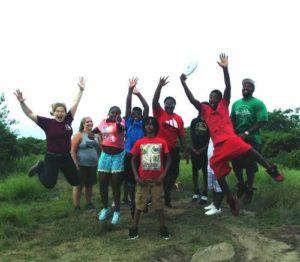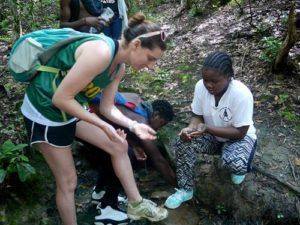by Amanda Wheelock
Working with New Audiences: Sharing a Chance to Love the Outdoors
As outdoors people in an age when we spend the vast majority of our time inside, we are keepers of one of the world’s most important secrets. Spending time outside has been proven time and again to keep you healthy both physically and mentally, not to mention its capability to inspire awe and gratitude. Sharing outdoor experiences with people who haven’t previously had such opportunities, then, is critically important work.
But just because something is important doesn’t make it easy.
People who have grown up with little access to an “outside” that doesn’t include a lot of tall buildings will probably feel out of their comfort zone surrounded by trees that, to the untrained eye, all look the same. For those who have rarely spent time in the woods before, hiking can seem scary, exhausting, uncomfortable, pointless, or all of the above. And, as we all know from our own scary and challenging moments in the outdoors, forcing people to leave their comfort zones, while important and rewarding, can be a real challenge.
This summer, ATC’s southern regional office partnered with several camps for disadvantaged youth with the hope of sharing our love for the outdoors, work we know is important and necessary.
This knowledge, however, doesn’t always mean that the work is easy or instantly rewarding. Outreach can be messy. The positive blurb in the grant report – you know, the one that reads “this summer, ATC brought disadvantaged youth to the Trail, many of whom have grown up just 30 minutes away but had never even heard of the A.T.! They enjoyed the views from Max Patch, looked for fires from the fire tower on Rich Mountain, and even helped us manage invasive exotic plants!” – doesn’t always reflect the moment-by-moment reality of this work. Sometimes you reach the awesome view, and there is no excitement. Sometimes there is struggle just getting kids to walk, or to stop throwing rocks, and it can be really frustrating when the awe and appreciation that you feel isn’t shared.
But that doesn’t mean that the work isn’t worth it. Because there are also moments like when I got to see a young girl’s face light up when she saw her first salamander, and the moment when a boy cutting invasive plants said “I want to do this as my job!,” and I got to tell him that he really could – that that job exists. Based on lessons we learned this year, here are some important things we’ll keep in mind to create more of those types of moments, and minimize the first kind:
1. Co-lead the trip with leader that kids already know and respect. As much as you’re able, involve teachers, counselors, or other chaperones kids already know in the planning and trip preparation, so that you have their buy-in when the time comes. You have time to show them a map and some photos of the section you’ll be hiking? Great. They can come scout the hike with you before the trip and learn some Leave No Trace basics? Even better.
2. Offer a choice of activities if possible. Just because you’re an athlete doesn’t mean you like playing soccer and running cross-country. Similarly, just because a kid dislikes hiking doesn’t mean she won’t love kayaking or biking. Giving kids a choice allows them to do what they’re interested in and gives them ownership over how they spend their time. Try a hike, an orienteering challenge, and some “low-ropes” team building exercises for a fun, choice-filled day on the A.T.

3. Think carefully about positionality. If you’re engaged in outreach work, you hopefully already understand some of the historical exclusion that taints environmentalism (and if you don’t, read this and this for starters). Positionality – how you’re positioned in relation to others, most often in regards to race, gender, leadership role, etc. – springs from the idea that such a legacy still affects the way people experience the outdoors today. Put simply, positionality means that if you have two white trip leaders supervising a group of black teenagers cutting invasive species on a sweltering day, you probably shouldn’t be surprised when one of them makes a comment about feeling like a slave. This is why listening to people more familiar with the kids you’re working with and their backgrounds is vital, as it can help bridge the gaps and build an activity curriculum that is educational, fun, and approachable for those unfamiliar with outdoor experiences.
4. Don’t forget context. Similarly, taking time to understand where kids come from and why they respond in the ways they do is crucial. Kids who associate rivers with the dirty, polluted one that runs through their city may not be as excited about swimming in a mountain stream as you are. Kids whose only interaction with the woods has been watching horror movies may be overly scared of snakes, bugs, or bears. Offer the chance to ask questions before heading out on an adventure, and if someone asks a question that seems ridiculous, try not to respond with a smirk or a chuckle – what you see as ridiculous may seem totally reasonable to someone with different experiences.
 5. Start small and be flexible. While we love the A.T., its closest day-hiking spots are at least 45 minutes from Asheville, and usually more. When working with this camp, we could have done a better job of utilizing trails closer to town and being adaptable to what kids want to see. We found out pretty quickly that these kids weren’t moved by beautiful mountain views, because they felt that they already see similar views in town without ever having to expend any effort. Pivoting and planning based on their interests and needs is crucial for a more successful hike.
5. Start small and be flexible. While we love the A.T., its closest day-hiking spots are at least 45 minutes from Asheville, and usually more. When working with this camp, we could have done a better job of utilizing trails closer to town and being adaptable to what kids want to see. We found out pretty quickly that these kids weren’t moved by beautiful mountain views, because they felt that they already see similar views in town without ever having to expend any effort. Pivoting and planning based on their interests and needs is crucial for a more successful hike.
6. Finally, don’t sweat the small stuff. Working with large groups of kids, especially kids you don’t know, is always going to involve obstacles, and the potential for chaos only increases when you take kids out of their comfort zones. In the same way that I would be absolutely grumbly if you tried to drag me through a shopping mall for five hours, some kids just won’t like hiking, and their attitudes will reflect that. That’s okay. Enjoy the time with kids who do respond, make it fun by bringing along some trail games and activities, find the magic in nature and stop to examine the salamanders and the bright orange mushrooms.
We all have our own passions. While I may spend a weekend backpacking on the A.T., another young woman might be reading a great book, or designing a website for a friend, or training for a marathon. And while not everyone loves the outdoors – and that’s 100% okay – I personally believe that everyone should at least be given the chance to love it. If no one ever takes you on a hike in the woods, or a swim at the ocean, or a simple walk by the river, how are you ever going to know whether you like it or not?
